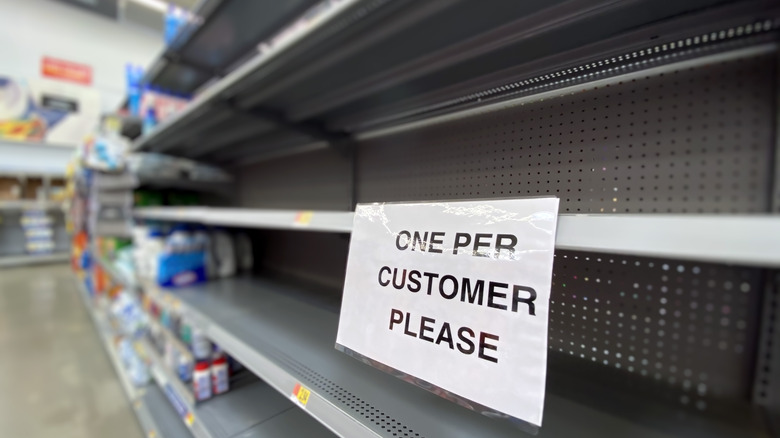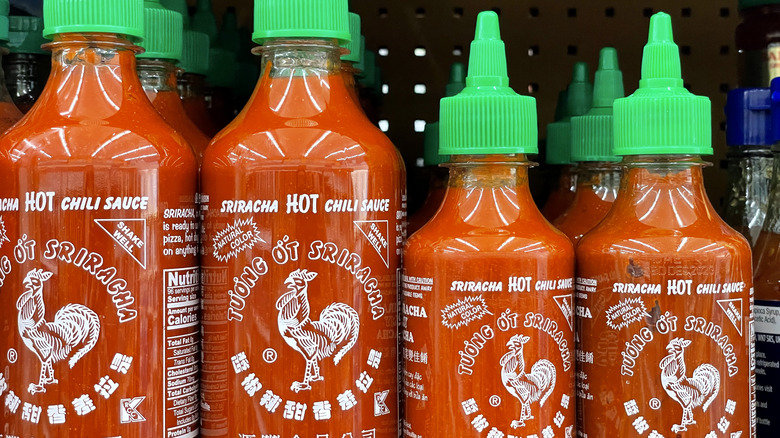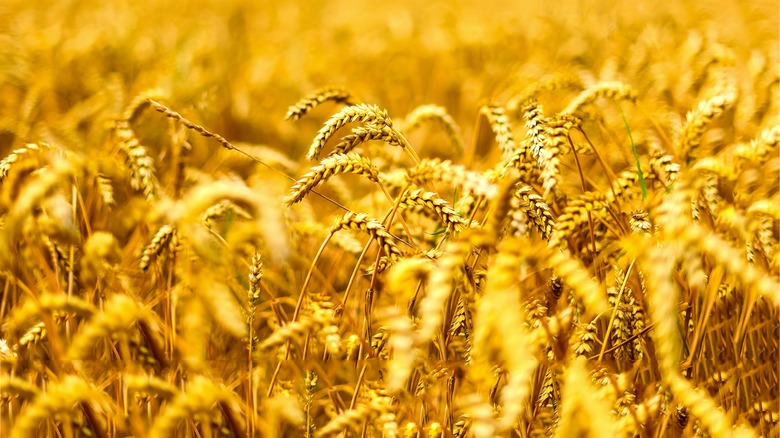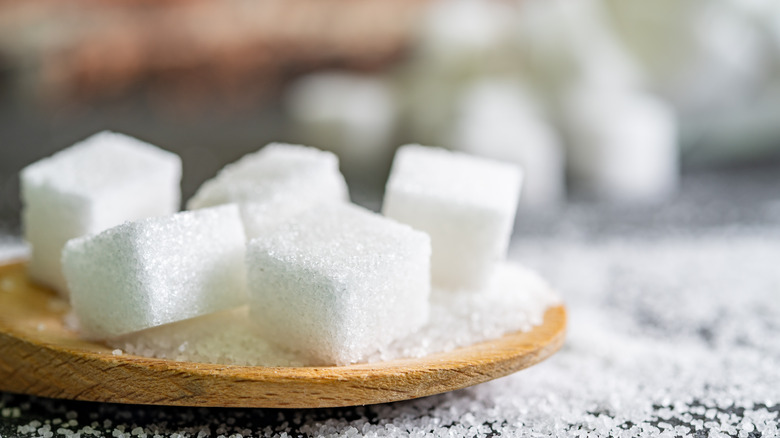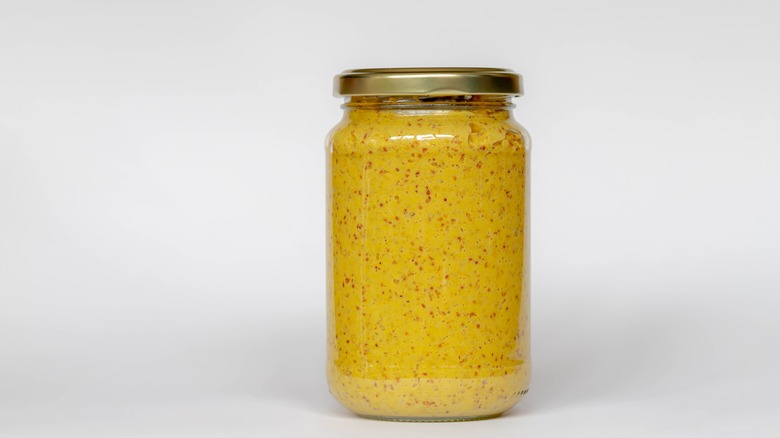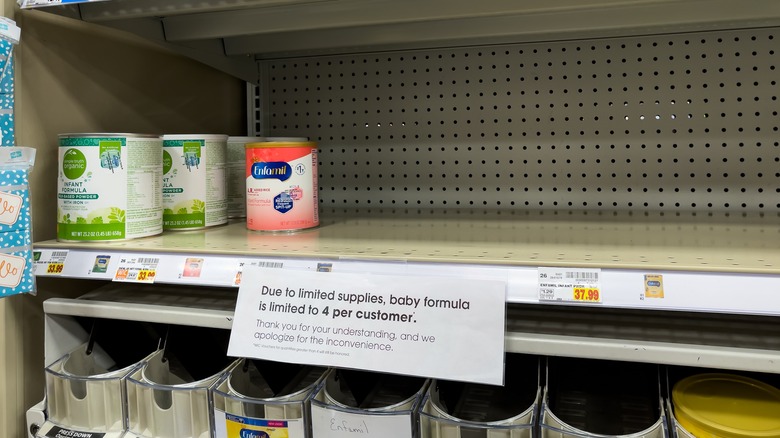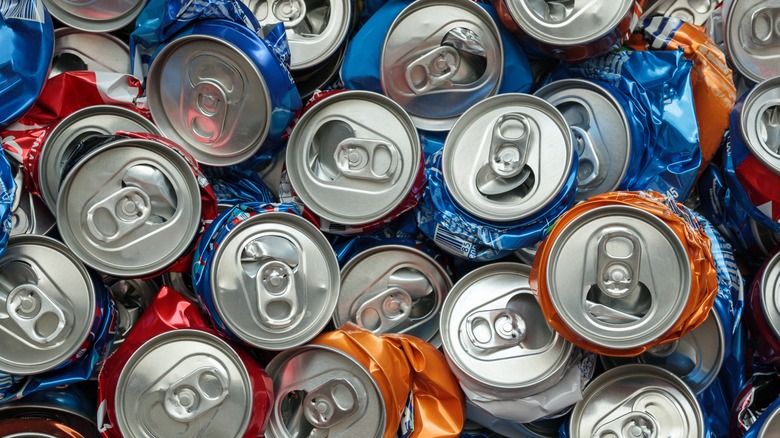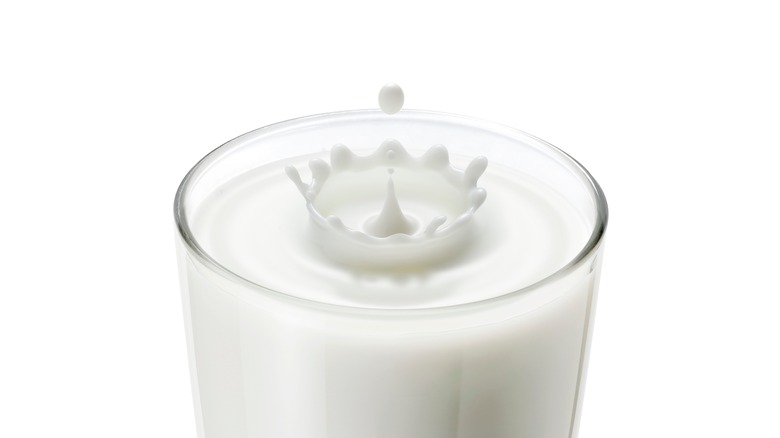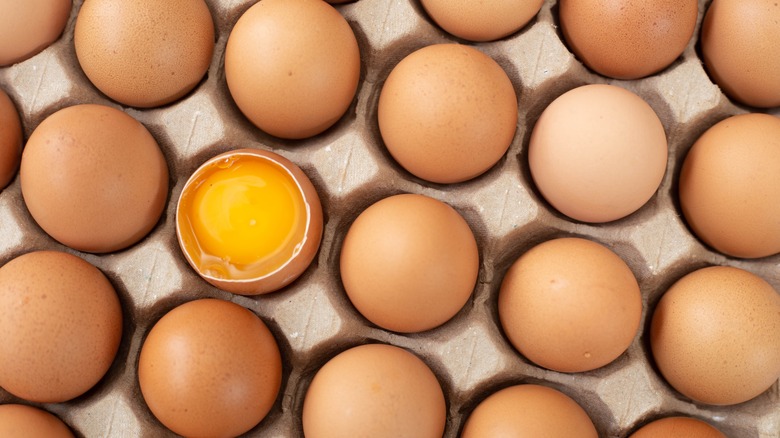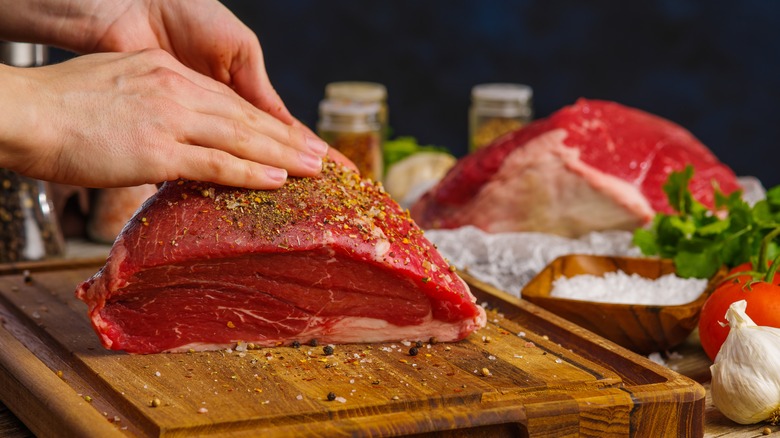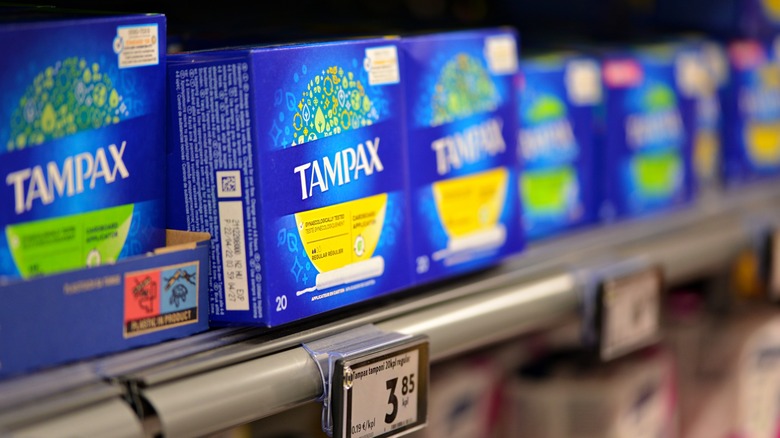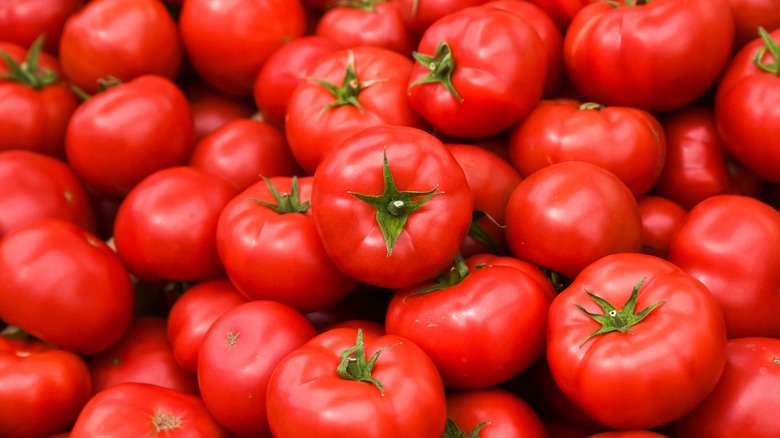16 Things That Might Disappear From The Grocery Store
It's not your imagination: Grocery store shelves are getting more and more barren by the minute, thanks to pandemic-related supply factors and the war in Ukraine (via MIT). Although we've already lived through the Great Toilet Paper Shortage of early 2020, other items are rapidly disappearing from store shelves from Anchorage to Atlanta. In addition, staples like chicken, milk, oils, and fruit are skyrocketing in price, causing us to wonder just how much we'll have to shell out for our morning bananas (via Yahoo).
Parade notes that these sad and skimpy store shelves are the culmination of a perfect storm of factors, including supply chain woes and COVID-related personnel problems. Throw in the war in Ukraine messing up the wheat supply, and you have a recipe for disaster, and frankly, not much else (via The New York Times). So which one of your faves should you stock up on ASAP? We've got the breakdown.
1. Sriracha
For many cooks, Sriracha chili sauce is a fiery little ace up their sleeve, ready to give otherwise mundane meals a tasty kick in the butt. But unfortunately, stocks of this tantalizing condiment are on the decline thanks to a disruption in chili pepper manufacturing. According to an official letter from the company, Huy Fong Foods is holding off on bottling any more of the good stuff until early fall. The reason for the pause is the chili crisis that started in the first few months of the pandemic but is really ramping up today.
Huy Fong Foods cites climate change and subpar peppers as significant contributors to the chili drought and mentions several products affected by the shortage, including its legendary Sriracha sauce. The good news is that Huy Fong Foods aims to jumpstart production in the fall, so hopefully, we won't have to be without our favorite spicy and scrumptious condiment for too long.
2. Wheat
One of the major ripple effects of the ongoing war in Ukraine is that wheat and wheat-related products like bread are getting more expensive. According to CBS News, prices of plain old ordinary flour have been going up and up since the war began and are slated to rise over 30% more. Inevitably, the cost will trickle down to customers who could find themselves shocked by the inflated price of their regular loaf of Wonder Bread.
Nicknamed "Europe's breadbasket," Ukraine's uniquely fertile soil produces some of the best wheat on the planet, but farming has been disrupted during the ware with Russia (via Financial Times). To make matters worse, other countries like India are severely cutting back on wheat exports (via Bloomberg). Wheat is one of those things that you might not miss until you don't have it. Prepare for more expensive bread, noodles, crackers, and other doughy delights as long as the war machine is still turning in Ukraine.
3. Sugar
Proving that everything in the world is somehow interconnected, the global energy crisis will lead to a new food shortage that seems totally unrelated. According to Reuters, sugar could be next on the chopping block. As sugar-producing behemoth Brazil anticipates fallout from the increase in energy prices, the country is expected to use more sugarcane for ethanol fuel instead of converting it to the sweet stuff and sending it around the world.
Unfortunately, Brazil is far from the only sugar buzzkill. There's also a shortage in the Philippines, prompting soda giant Coca-Cola to temporarily halt production in the country (via Nikkei). Like wheat, sugar is something that you don't really miss until you don't have it. Plenty of packaged foods, even savory ones, have a lot of added sugar (via The New York Times), so it's not just cakes that you won't be able to snack on; it's pasta sauces, marinades, and prepared foods too.
4. Mustard
While mayo and ketchup are America's first- and second-favorite condiments (via People), mustard is quite popular too. That's what makes it such a shame that this spicy and tangy sauce might go the way of the dodo bird, at least for a little while. According to USA Today, the mustard shortage is climate change-based, a wicked result of bone-dry fields in North America, specifically in Canada. Unfortunately, since mustard farms are being negatively impacted by the drought, commercially-produced mustard might not be able to make it onto your Labor Day hot dog.
The outlook is pretty bleak for 2021-2022, with mustard seed production slashed and seed prices going through the roof. That means that even if you can find your favorite mustard brand on store shelves, it could cost you more than just a little bit extra. If you see a bunch of your favorite mustard in the supermarket, stock up now before it's too late. Fortunately, production could increase next year, which could ease price hikes somewhat.
5. Toilet Paper
Everyone who remembers the first few frightening months of the COVID-19 pandemic will recall the long lines and mad dashes for toilet paper. According to The Washington Post, the TP shortage was one of the defining features of the early months of the pandemic. But, unfortunately, just when you thought it was safe to go to the store without buying two giant packages of toilet paper "just in case," we might be headed for round two.
According to Bloomberg, it's not pandemic panic fueling the second wave. It's paper pulp. As with many food and supply shortages, the war in Ukraine is partially to blame. Russia is one of Europe's biggest pulp producers, and it has not exported this resource since the invasion began. Also, toilet paper production eats up a lot of energy, which is an uncertain and limited commodity at the moment (via Euro News). As less toilet paper gets produced, fewer rolls wind up on the shelves, and Americans have already taken notice and ramped up purchases of this personal product (via The Wall Street Journal).
6. Baby Formula
The ongoing baby formula shortage is a nightmare for new parents, and unfortunately, it doesn't seem to show any signs of easing up soon. According to The Wall Street Journal, popular brands like Gerber and Enfamil are consistently out of stock. As with plenty of food shortages and high-priced staple items, the baby formula shortage is likely a direct result of supply chain hold-ups, making it challenging to get the formula to the stores themselves and get the ingredients needed to make the formula.
Couple these supply chain hiccups with factory shutdowns and product recalls (via American Progress), and you have a genuinely alarming situation. Unfortunately, some parents are taking the formula shortage into their own hands by concocting at-home blends that may not be safe for infants' tummies (via Peoria Journal Star). Although there's not much of an immediate solution to the formula crisis, homemade infant formulas are not a good idea, as they might make your baby sick.
7. Pet Food
It's not just the human children experiencing fallout from grocery shortages — America's fur babies are too. According to Fox Business, the pet food shortage is causing owners to scramble for alternatives to feed Fido and Fluffy. Unfortunately, this shortage is worse for pets with special diets, and while you can still get pet food, it might not be the particular brand your dog or cat wants.
As with most shortages, the great pet food crisis is the cumulative effect of many different things, including supply chain woes and problems getting certain ingredients. It's exacerbated by the number of new best friends Americans adopted at the height of the COVID-19 pandemic. Canned dog food has been hit hardest by the shortage, and the primary culprit is that manufacturers are having a hard time sourcing aluminum (via KLTV). Rising ingredient prices are also partially to blame. In short, it's a mess, but if you survived the toilet paper shortage of 2020, you know that a little resourcefulness can get you through tough times. Unlike baby formula, dog food is safe to make at home.
8. Alcohol
According to Wine Magazine, you could have to wave bye-bye to the bubbly for the time being unless you want to pay quite a bit of money. Prices for sought-after suds like champagne are going up, and as usual, plenty of factors are to blame. The global supply chain screeching to a halt in light of COVID-19 is one of the critical factors. Another problem is that decreased demand in 2020 caused champagne producers to reduce production. When champagne sales went back up, it put a strain on the supply that might continue for several years.
Champagne isn't the only booze that could be getting more expensive. As Metro West Daily News reports, your average beer cost is going up too. Not only are some of the traditional beer-making materials in shorter supply, but aluminum cans are getting more expensive. So soon, having that celebratory TGIF drink could really cost you, whether at the bar or from the grocery store fridge.
9. Canned Beverages
Canned beverages could be undergoing a much more pricy makeover thanks to America's ongoing aluminum can shortage. According to Quartz, aluminum is one of the most sought-after container materials. This demand went up as housebound Americans drank and ate at home during the grim early days of the COVID-19 pandemic, and while they consumed a lot of beverages packaged in aluminum cans, recycling operations took a dip, making the demand for aluminum shoot up (via Recycling Today).
Craftlab notes that the recent uptick in hard seltzer made cans a lot cooler and more in demand. Canned cocktails are also the new, convenient drinks du jour (via CNBC). Traditional beer makers who turned to the humble can as a lighter, cheaper alternative to conventional bottles are also feeling the aluminum can crunch (via NPR). According to NPR, the roots of the aluminum can shortage woes are supply chain issues and huge demand for these lightweight, affordable, portable containers.
10. Milk
Milk is a nearly universal staple in American households, with over 90% of families having it in their fridge (via the Center for Dairy Excellence), so it's a little alarming to know that we're in the middle of a massive milk crisis. According to KWCH, milk has fallen victim to one of the biggest villains of the post-pandemic world: Supply chain problems. Processing and shipping raw milk is really the issue; there's still enough milk being produced by dairy farms, but getting it packaged and delivered to places where it can be sold has become more challenging.
Plant shutdowns at colossal brands like Borden are also affecting the availability of specific milk products (via Dairy Herd). While you'll likely see less variety and pricier half gallons at your local store, people are paying close attention to another side of the milk shortage as well. According to WVUA 23, school kids could have trouble getting those child-sized mini cartons of milk that we all grew up with and loved. Hopefully, the powers that be will get a moo-ve on this shortage soon.
11. Eggs
These breakfast time faves could vanish from stores near you or at least come with a weighty price increase. According to The National Desk, egg costs are on a serious upswing. There are a few key reasons why you might have to pay extra for your fix of sunny-side-up eggs and toast. Climate change is a key component, resulting in puny eggs and fewer eggs in general.
Additionally, flocks of egg-laying chickens are falling prey to a bout of bird flu that's been wiping out hens and wreaking havoc (via The National Desk). Today notes that farmers must put down infected birds due to the highly contagious flu. Along with hot and inhospitable conditions, this bird flu is transforming eggs into a rare and pricey commodity. From Walmart to your local farmer's market, finding a carton of eggs that won't cost you a limb and your firstborn child is really tough these days.
12. Meat
According to Business Insider, the COVID-19 pandemic shook up the meat industry in cataclysmic ways. Supply chain issues account for part of the issue, with the pandemic ripping considerable holes in the infrastructure for the production and distribution of meat products (via SSRN). However, beyond the typical supply chain distress and headache, giant meat factories dealt with rampant COVID-19 infections, which disrupted production.
Tyson Foods had one such outbreak (via Business Insider), and according to its CEO, prices are consistently high today because of the enormous demand for beef (via Tyson Foods). Whether it's pandemic-related challenges or high demand for meat products or a combination of both, there's no denying that carnivores are feeling the pinch at the supermarket. As Vox notes, it's probably of all of these things, plus inflation, price gouging, and good old-fashioned greed. Maybe it's time for Meatless Mondays to become a trend for frugal and wise American households.
13. Chickpeas
If you love hummus or habitually sprinkle a few chickpeas in your salad, you could soon be out of luck. According to Reuters, chickpea production is way down thanks to the double punch of the war in Ukraine and climate change. Both Russia and Ukraine are important chickpea producers, and the war has damaged their ability to export their products. Volatile weather in the U.S. has wrecked the chickpea crop here as well. Fewer chickpeas could lead to pricier hummus, and if you make it yourself, you might find the raw ingredients for this yummy spread to be up quite a bit in cost too.
Modern Farmer notes that the humble chickpea is another victim of supply chain snafus, although this time it's on a global scale. The publication also offers a grim warning: One of the reasons we will see fewer chickpeas on the shelves is a fertilizer shortage that could also hurt other vital crops.
14. Tampons
Thanks to supply chain problems, it might be harder to find tampons at your local store (via Time). These essential items are scarcer than ever thanks to issues with both raw materials and shipping (via Cnet). While legacy tampon-producing brands like Proctor and Gamble promise that the flow of tampons won't be halted for too long, it's still bad news for plenty of people who can't find their favorite brand.
According to The New York Times, inflation is another big reason why people are seeing massive price tags on essential period-related products, with the price of tampons increasing 10% in just the first half of 2022. The publication also noted that major stores like Walgreens and CVS recently ran out of some popular brands. Although tampons might be a tricky item to get your hands on, The New York Times warns against trying to prolong the life of your tampon as that could lead to toxic shock syndrome. Pads are a viable alternative in a pinch.
15. Popcorn
While most movie theaters have reopened post-pandemic and are seeing plenty of return customers (via The New York Times), there is one not-so-delicious surprise awaiting guests: a popcorn shortage. According to The Wall Street Journal, this popcorn scarcity could affect the rest of the blockbuster season, and it's not just the cinemas feeling it — consumers will too.
According to Spectrum Local News, popcorn shortages are expected in Texas due to a decrease in corn production. The USDA notes that corn production has dipped roughly 4%, with states like Massachusetts and Rhode Island planting fewer acres of the crop than ever before. This means that savory corn and corn-related products could be harder to find, and it also doesn't look good for the bagged popcorn on store shelves. Since Americans are enthusiastic and frequent popcorn consumers (via ABC 13), a shortage may deprive you of your favorite crunchy treat for your next Netflix session.
16. Tomatoes
According to Cnet, California's tomato crops could be the next victims of climate change, thanks to an ongoing, catastrophic drought in the Golden State (via Washington Times). As a result, you can expect scarcer selections of tomatoes at your local grocery store, and tomato-based products could be on the chopping block too. Cnet notes that tomato-based sauces and salsas could see a pricing double-whammy, both from the tomato shortage and ongoing inflation woes.
California vastly outperforms all other U.S. states in tomato production (via Statista), and its parched farmland is likely to have massive impacts on the tomato supply for months. According to Taste of Home, you can expect to pay bank for standard, generally cost-effective staples like pasta sauces and condiments. As much as it hurts to break our huge nationwide reliance on tomatoes, it's economical and smart to look elsewhere, swapping out vodka sauce for herbaceous pesto until California's farmland is viable again.
